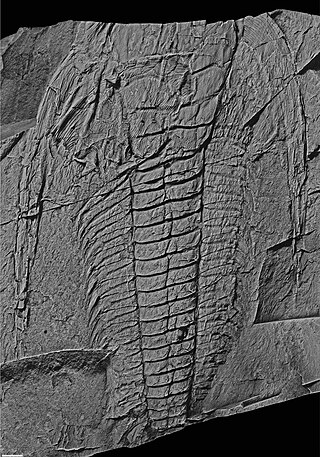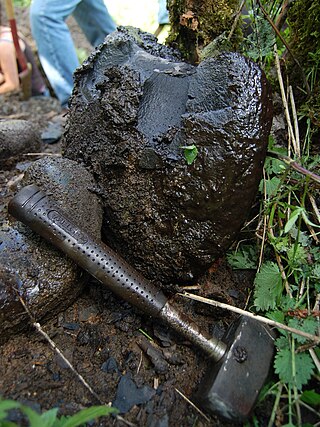
The Early Ordovician is the first epoch of the Ordovician period, corresponding to the Lower Ordovician series of the Ordovician system. It began after the Age 10 of the Furongian epoch of the Cambrian and lasted from 485.4 ± 1.9 to 470 ± 1.4 million years ago, until the Dapingian age of the Middle Ordovician. It includes Tremadocian and Floian ages.

John William Salter was an English naturalist, geologist, and palaeontologist.

The Tremadocian is the lowest stage of Ordovician. Together with the later Floian Stage it forms the Lower Ordovician Epoch. The Tremadocian lasted from 485.4 to 477.7 million years ago. The base of the Tremadocian is defined as the first appearance of the conodont species Iapetognathus fluctivagus at the Global Boundary Stratotype Section and Point (GSSP) section on Newfoundland.
The Furongian is the fourth and final epoch and series of the Cambrian. It lasted from 497 to 485.4 million years ago. It succeeds the Miaolingian series of the Cambrian and precedes the Lower Ordovician Tremadocian Stage. It is subdivided into three stages: the Paibian, Jiangshanian and the unnamed 10th stage of the Cambrian.
Santa Rosita may refer to:

The Alum Shale Formation is a formation of black shale of Miaolingian to Tremadocian in age found predominantly in southern Scandinavia. It is shale or clay slate containing pyrite. Decomposition of pyrite by weathering forms sulfuric acid, which acts on potash and alumina constituents to form alum, which often occurs as efflorescences on the rock outcrop.
Stage 10 of the Cambrian is the still unnamed third and final stage of the Furongian series. It follows the Jiangshanian and precedes the Ordovician Tremadocian Stage. The proposed lower boundary is the first appearance of the trilobite Lotagnostus americanus around 489.5 million years ago, but other fossils are also being discussed. The upper boundary is defined as the appearance of the conodont Iapetognathus fluctivagus which marks the beginning of the Tremadocian and is radiometrically dated as 485.4 million years ago.

Paleontology or palaeontology is the study of prehistoric life forms on Earth through the examination of plant and animal fossils. This includes the study of body fossils, tracks (ichnites), burrows, cast-off parts, fossilised feces (coprolites), palynomorphs and chemical residues. Because humans have encountered fossils for millennia, paleontology has a long history both before and after becoming formalized as a science. This article records significant discoveries and events related to paleontology that occurred or were published in the year 2013.
Westergaardodina is a species-rich genus of spine, U or W-shaped paraconodont known from Middle Cambrian to Lower Ordovician strata.

Paleontology or palaeontology is the study of prehistoric life forms on Earth through the examination of plant and animal fossils. This includes the study of body fossils, tracks (ichnites), burrows, cast-off parts, fossilised feces (coprolites), palynomorphs and chemical residues. Because humans have encountered fossils for millennia, paleontology has a long history both before and after becoming formalized as a science. This article records significant discoveries and events related to paleontology that occurred or were published in the year 2014.
Granomarginata is a genus of spherical Cambrian acritarchs interpreted as a phytoplankton.
Cordylodontidae is a family of conodonts.
Proconodontida is an order of conodonts which originated in the late Cambrian (Furongian) and persisted partly through the Ordovician. The ancestral proconodont, Proconodontus, was one of the earliest euconodonts to appear. Proconodonts are often equated with the broader group Cavidonti, which occupies one side of a basal division in the evolution of early euconodonts in the Cambrian. All other euconodonts occupy Conodonti, the other side of the Cambrian split.
Acodus is an extinct genus of conodonts.

Acanthodus is an extinct genus of conodonts.
Utahconus is an extinct genus of conodonts.

Variabiloconus is an extinct genus of conodonts.
Eoconodontus is an extinct genus of conodonts of the Late Cambrian. It is a two-elements genus from the Proconodontus lineage.
Conodonts are an extinct class of animals whose feeding apparatuses called teeth or elements are common microfossils found in strata dating from the Stage 10 of the Furongian, the fourth and final series of the Cambrian, to the Rhaetian stage of the Late Triassic. These elements can be used alternatively to or in correlation with other types of fossils in the subfield of the stratigraphy named biostratigraphy.
The Glenogle Formation or Glenogle Shale is a stratigraphic unit of Ordovician age. It is present on the western edge of the Western Canada Sedimentary Basin in southeastern British Columbia. It consists primarily of black shale and was named for Glenogle Creek in the Kicking Horse River area by L.D. Burling in 1923.






